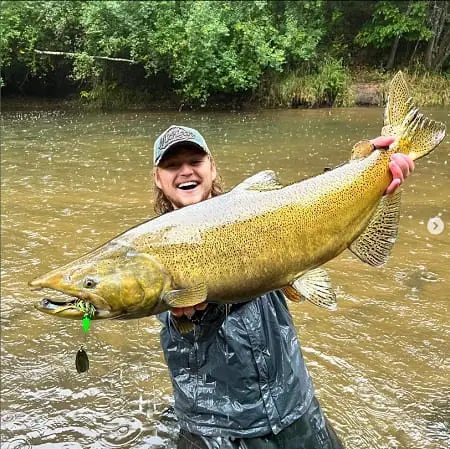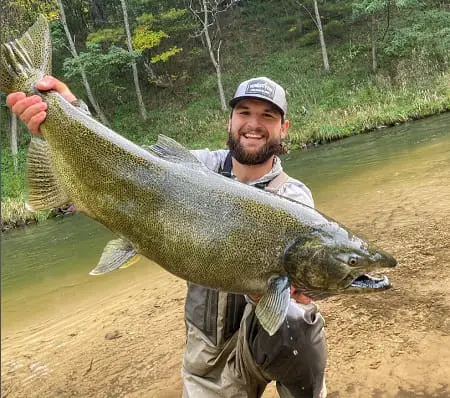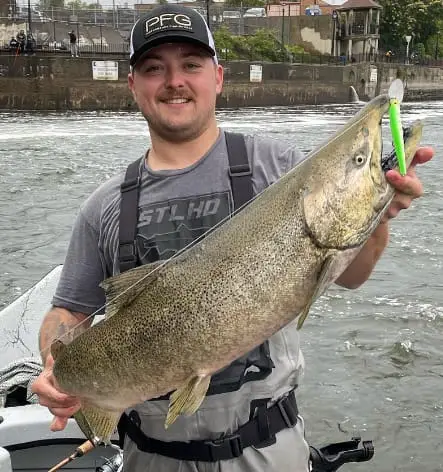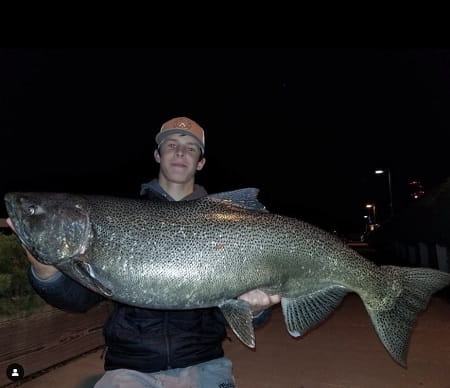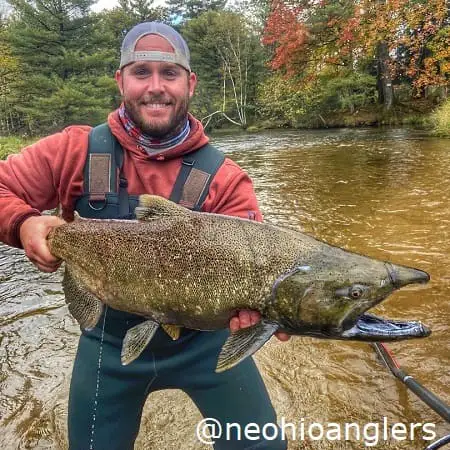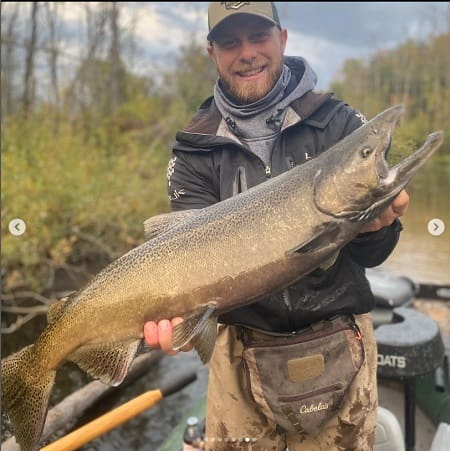Lure Fishing For Salmon: How The Guides Do It
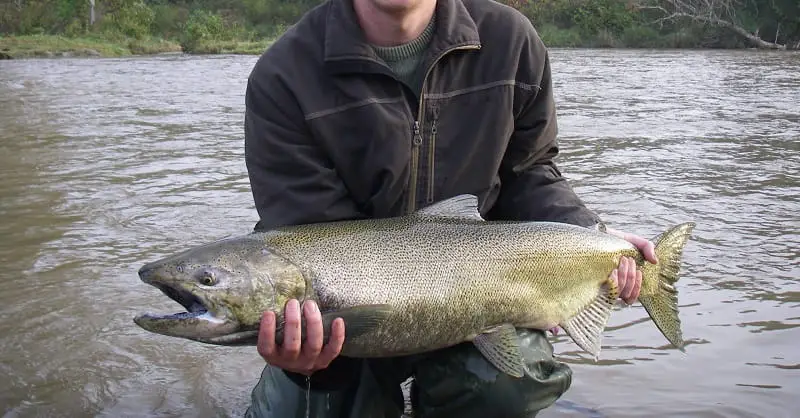
Catching salmon with lures in rivers requires the angler to use lures that work well in current and retrieval methods that trigger salmon to bite. Using the right methods and the right lures based on the conditions and salmon behavior is essential.
As a salmon guide for the last 22 years, I use methods that have been tested and proven to be the most effective methods used by river guides.
If you are not using these methods combined with proven lures, you are missing fish.
We may make a small commission from some of the links on this website, which is at no cost to you. I appreciate your support.
Lure Fishing For Salmon: 5-Step Process
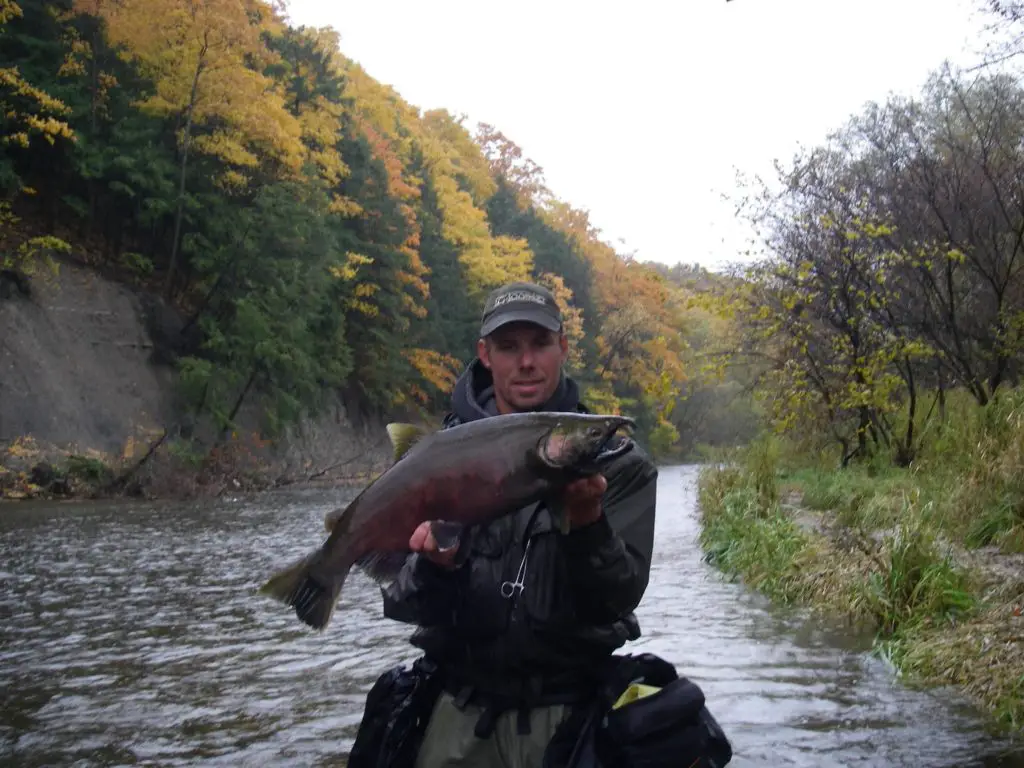
Fishing for salmon with lures can be one of the most effective methods for catching all species of salmon anywhere in the river, from the shore, or from a boat.
However, simply casting lures aimlessly, which is what most anglers do, isn’t effective, and it isn’t what river guides do.
- Gear: You will need to use the right gear, which includes an eight to nine-foot medium-heavy or heavy rod, with a 4000 to 4500-size reel combined with braided line, mono, or fluorocarbon line. A fluorocarbon leader and snap swivel can also be used.
- Lures: Good lures include spinners, spoons, jigs, crankbaits, and plugs. You must determine when and where these lures work best.
- Read The River: Learning how to read the river and determine where the salmon hold, as well as travel routes, is required so you know where to fish with your lures.
- Cover The Water: I use a systematic approach to covering the water, which enables my clients and me to catch a lot more steelhead. Every cast is positioned in a spot for a purpose, so I put my lure in front of every salmon in the spot.
- Depth: Knowing how deep your lure is, how to get it deep enough, and how to keep it in the salmon’s strike zone is critical to success.
- Work Your Lure: Good lure anglers will work their lures in ways that trigger a strike response, which means more fish. Different lures work in different ways, and I have ways to make my lures much more effective.
Best Lures For Salmon
It’s essential to know which lure to use, as well as the best sizes and the best colors based on the conditions.
I change lures, colors, and sizes frequently when the fish are not biting, and I will stick with working lures.
The best salmon lures in rivers are:
- Kwickfish – Best in slow water or when the salmon are inactive.
- Spinners – Generally good in all types of water, and they make a lot of noise so they are good in off-colored or dirty water.
- Spoons – Spoons are best in slow to medium-speed currents and are great at river mouths or where far casts are required.
- Crankbaits – Crankbaits are generally good in all types of water, however, some of the shallow-lipped crankbaits do not work well in faster currents.
- Jigs – Jigs will work well in all types of water but can be the most effective lure in small pocket water or when you need to get a lure around large boulders.
The best lures for salmon should also have good action or an action that works in the conditions of the spot you are fishing in.
Lures and Conditions
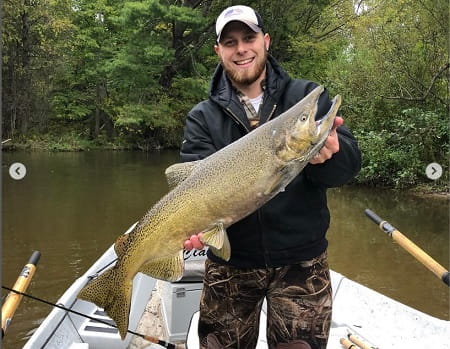
Salmon can often be picky about the lure or the action of the lure. With a quick switch to a different lure and within a cast or two, my clients are hooked into salmon.
The action and the look of the lure are extremely important and are often what triggers the salmon to aggressively bite the lure.
You should have an assortment of lures to cover all conditions. You want lures that can go deep, or that can be fished shallow, or fished fast, or fished slow.
I will fish jigs just like lures, and I call this twitching for salmon. Jig fishing for salmon can be used in all types of river situations and for all salmon species.
Some rivers might be clear and some dirty, so depending on the water clarity, I will also adjust the size and color of my lures.
Dirty Water: Often, in dirtier water, I will choose a straight-moving lure that can be fished slowly, and I prefer a lure that makes noise. Rattles and vibrations are the best in dirty water.
Clear Water: Most lures will work when the water is clear However, I may need to change colors to determine what they want.
Fast water: Some lures like spoons and plugs do not work well in fast water. It is better to use crankbaits and spinners in faster water.
The Right Size Lures For Salmon
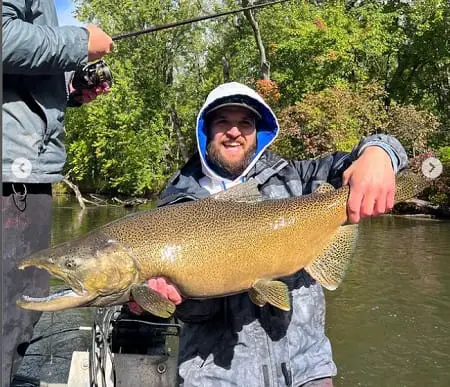
For most salmon fishing with lures, lures from 3 to 5 inches are best.
I change my lure sizes based on a number of factors, and every day can be different, and every spot can be different.
These are the top things I consider when choosing the best lure size for salmon.
- The average size of the fish in the rivers: Big fish mean big lures!
- The fish’s activity level: Aggressive fish will hit bigger lures, and less aggressive fish will be more inclined to bite a smaller lure or a slow-moving lure.
- The color of the water and the clarity: The dirtier the water, the bigger the lures. Here’s my guide tip for you, which I learned while doing a tournament and seeing what the most fish were caught on. Use noisy lures in dirty water.
- Size of the river that I am fishing: The small rivers may require smaller lures, while big rivers are best fished with bigger lures.
- The water temperature: The colder the water, or if there was a drastic drop in water temperature overnight, the salmon may be less aggressive, and a smaller lure might work better. As the water temps increase or stabilize, larger lures will be a good choice.
- The light conditions: In low light, I use bigger lures, brighter lures, or even glow lures.
I often start with lures on the smaller side. 3 to 4-inch lures are less likely to spook a nervous salmon in very clear water.
If they don’t eat the small lures, I will keep going up in size, up to 6 inch crankbaits. If that doesn’t work, I will start changing colors, lure types, and retrieve types. I will also change lures based on speed and lure action.
Use the Right Lure Size For The River
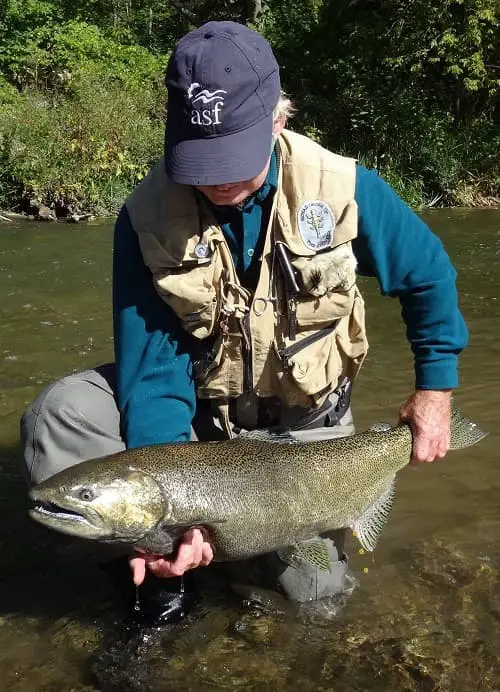
In small streams where I don’t need to cast very far, I will use lures that are much lighter and smaller, so I don’t spook the salmon.
These lures won’t make a big splash in a small pool and spook all the fish.
When lure fishing for salmon in larger rivers that require much longer casts, I will go to a larger-sized lure or a heavier lure that can be cast a long way.
The Right Lures For Low-Light Conditions
Under low light conditions and when fishing at night, I find that larger lures will work better than smaller lures. Lures that move slower and have some noise like a rattle or a vibration also tend to work better in low light conditions of early morning, dusk, and at night.
I also recommend glow lures.
Use The Right Lure Colors
- Clear Water: I tend to use more natural colors in clear water: blacks, browns, and greens, as well as silver, copper, bronze, and gold.
- Dirty Water: Bright is often a good idea. Chartreuse, hot orange, and red are often good options.
- High Water: Almost any color can be good in high water that is relatively clear. I will often switch from a light and bright color to a black or dark lure to see what the fish want. This is where a hot orange could efficiently work as well as black.
- Low Water: stick with the more natural colors mentioned above.
- Small Streams: I tend to stick with the more natural colors mentioned above. If those do not work, I will start trying brighter colors. Often, silver, gold, and copper will work well.
- Large Rivers: Same as high water where just about any color could work.
- Fast Water: Often, bright colors will grab their attention and can be best since fast water means your lures will be moving quickly, and you want to get their attention fast.
- Slow Water: Most colors can work, but I tend to start with more natural colors and then try brighter colors if those don’t work.
Salmon Fishing With Lures In Small Streams
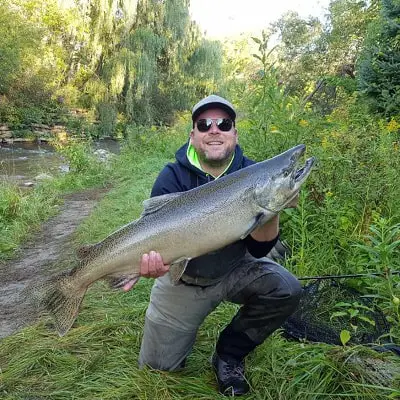
Catching salmon in small rivers doesn’t require heavy lures that can be cast far, and large lures can sometimes spook salmon holding in smaller clear pools. It’s best to start with small lures and then work your way to larger sizes.
The best lures to use in small rivers are spinners, spoons, and jigs, but I have done well with small plugs like Flatfish.
Salmon Fishing With Lures In Larger Rivers
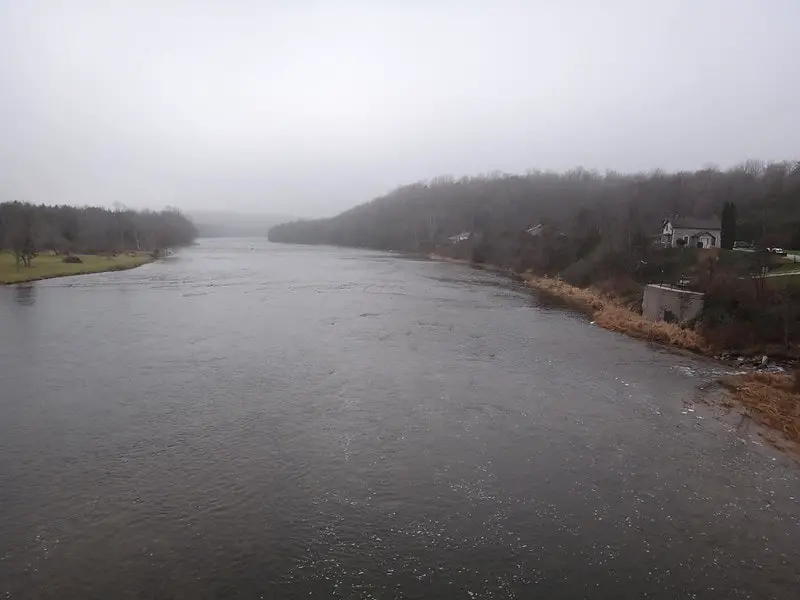
Larger rivers often require bigger lures or heavier lures that can be cast far enough to get to the fish.
Since many larger rivers are deeper, you will also need lures that can get deep enough.
Using a 5-inch Rapala crankbait that only dives 3 to 5 feet deep may not be the best option when the salmon are 12 feet down, so you will need to use lures that can get to the desired depth.
How To Fish Lures For Salmon Effectively
Covering the water properly means covering all areas of the spot and not leaving any spot untouched. It also means covering the water at the right depth or at least finding the right depth.
A good angler must also know how to work a lure since different lures work differently. Changing your retrieve or alternating from a straight retrieve to an erratic retrieve can make a big difference.
To cover the water well and work the lure properly, you need to be in the right position and you need to know how to get the lure in the strike zone.
Covering The Water Effectively With Lures
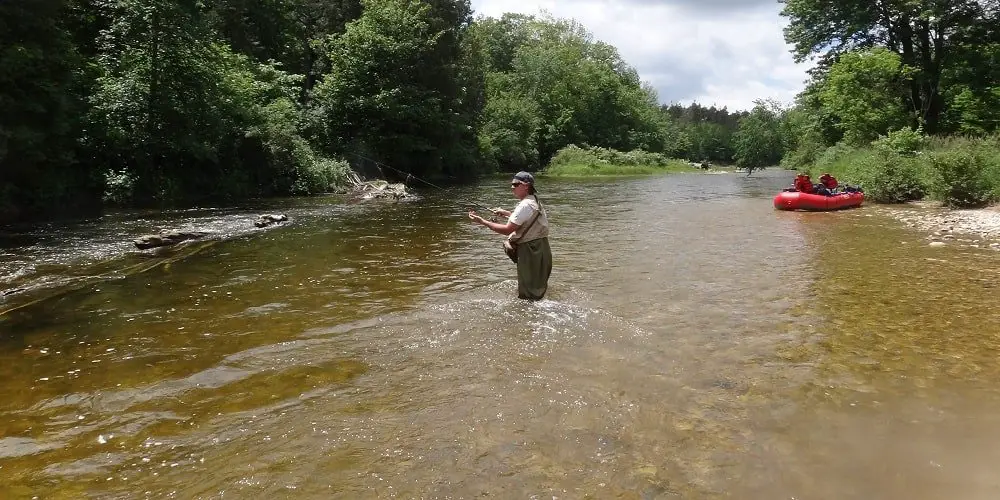
River guides will always cover the water systematically to maximize their chance of catching more salmon.
To cover the water with a lure effectively, you need to have your starting point and end point in mind and ensure you cover every 3 to 6 feet of the spot you will be fishing. See below.
You should almost always start casting at the top of the pool where the river goes from shallow to deeper, and then work your way down the pool.
To land your lure at the start of the deep water, this means you need to be standing 20+ feet upriver of where you want to present your lure because it’s going to swing downriver. See diagram
The picture below shows where the angler should stand and cast on his first and all consecutive casts.
Each cast should land about 3 to 6 feet apart so that the lure path is retrieved about 3 to 6 feet apart each time. In clear water, it’s not unusual for a salmon to move up to 6 feet to grab a well-presented lure.
Casting 5 or 6 feet apart is my go-to distance when the water is very clear, but when the water is dirtier, I will make each cast land 2 to 3 feet apart to be sure all the salmon see the lure. This is because they can’t see as far in dirty water.
On big rivers that are clear, I often go to every 5 to 6 feet apart just so I am able to cover a lot more water at a faster pace.
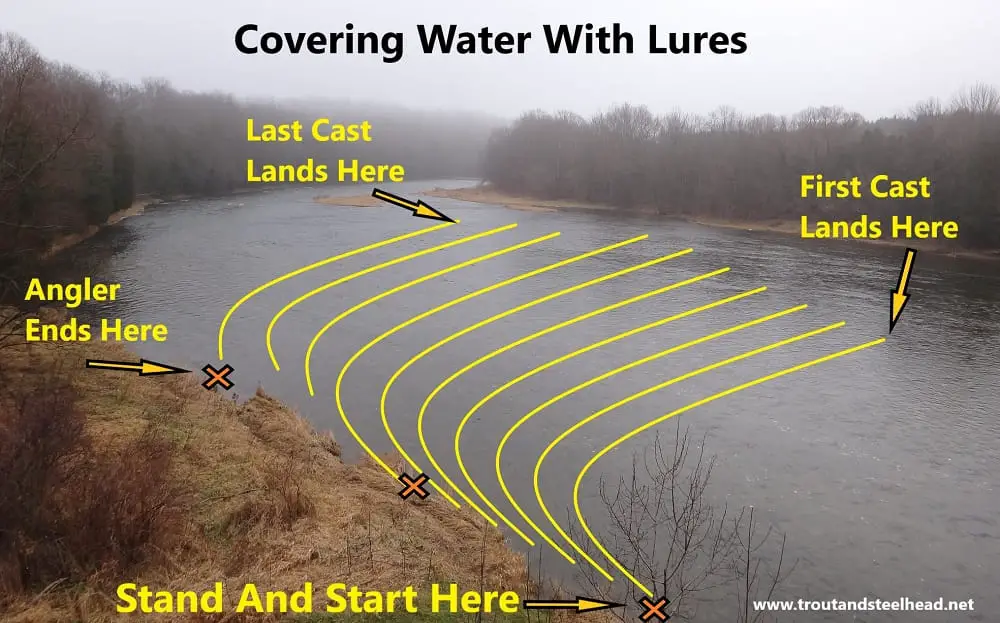
Cover The Depth Of The Water With Your Lures
Effective salmon fishing requires covering the water at all depths, and this can be a bit tricky. However, if you use these tips, you can really help you catch more salmon. We can’t see the bottom in many rivers, so we don’t know how deep the spot is.
If we cast out a spinner or a spoon and start retrieving it immediately, the lure may only go down 1 to 3 feet. That’s great if the spot is only 3 or 4 feet deep, but it’s bad if the spot is 10 to 12 feet deep and all the salmon are on the bottom.
In a river, many salmon won’t move more than 5 or 6 feet to hit a lure, so it’s always best to get the lure down and within 2 to 4 feet of a salmon so that we can catch the less aggressive fish.
The way I find the bottom is to use lures that run deeper, like a deep-diving crankbait or plug or I will use sinking lures like a spinner or spoon and allow them to sink to the bottom before I start to retrieve them.
FYI, a wide-blade spinner will run shallower than a thin-blade spinner, so keep that in mind when running spinners in deeper water.
Also, the lip on a lure will dictate its depth.
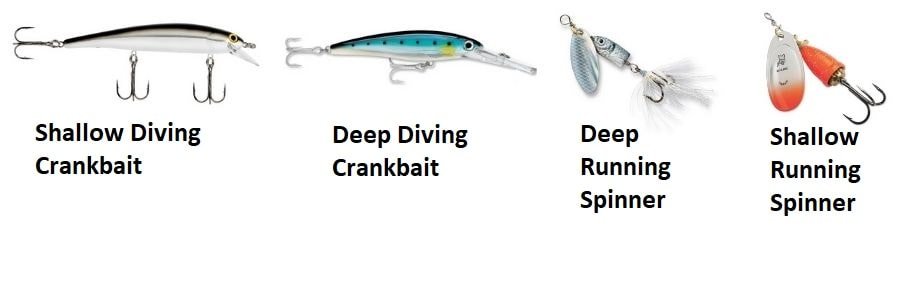
To find the bottom with a lure, I cast and make a retrieve with my rod tip straight out or pointed slightly toward the water. If I don’t hit the bottom, I will repeat the exact same cast in the exact same spot or the same path but this time I will retrieve it with my rod tip lower or even touching the water. If I don’t hit bottom, I repeat again, but this time with my rod tip a foot or two into the water.
If I hit bottom on any cast, I will lift my rod tip up, if it hit again partway through the cast I lift the tip even higher.
If I still don’t hit bottom, I will change my lure to a deeper diving lure or a weighted lure like a spoon or a spinner, and then repeat.
If I still don’t hit bottom with these sinking lures, I will cast and let the lure sink for a few seconds before I start my retrieve. If I hit bottom, I lift my rod tip, and on the next cast, I won’t wait as long before I start to retrieve.
If I still don’t hit the bottom, I will wait longer to let the lure sink deeper before I start my retrieve.
I will repeat these steps from the top of the spot to the bottom of the spot since the river can be deeper or shallower as you move down the river and cover the water.
Once you figure out the rod tip angles or the sink time of the lure that gets it to the bottom, all your other casts should be faster locating the bottom.
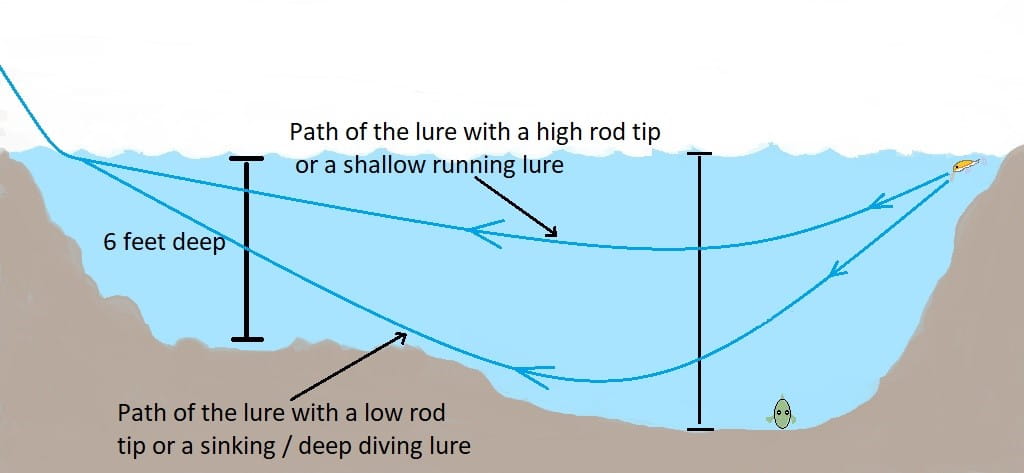
Lures that drag the bottom get hung up often, and you will likely catch fewer fish, so don’t drag the bottom unless you want to lose a lot of lures.
Work Your Lure For More Salmon
A lure that is cast out and then reeled straight in will catch fish, but a lure that is cast out and worked erratically with more action will catch far more fish. Other guides, pro anglers, and tournament anglers have proven this over and over again.
Salmon and other predatory fish have a harder time resisting a dying, struggling, or injured baitfish.
Therefore, if you reel your lure straight in, it looks healthy and fast and something that might get away, so it’s a harder target for the salmon, but if you jerk it, rip it, and then pause it, then it looks injured, and this is harder for even a neutral active fish to resist. Often, the more erratic, the better the results.
Even with spinners and spoons, I will reel it in 5 to 10 feet and then rip it or jig it with a split-second pause between rips and pauses to trigger more strikes. Try it, it works!
Best Lines For Salmon
There are four types of lines that could be used for salmon lures. Your options are Monofilament, Copolymer, fluorocarbon, and Braid.
Everyone has an opinion or a preference, but based on my experience, this is what I recommend.
Multipurpose Line
If you are a newer angler, go with a monofilament line like 12 to 14-pound Sufix Elite for Great Lakes Steelhead, or use a 14 to 17-pound line for West Coast Salmon or when fishing big rivers.
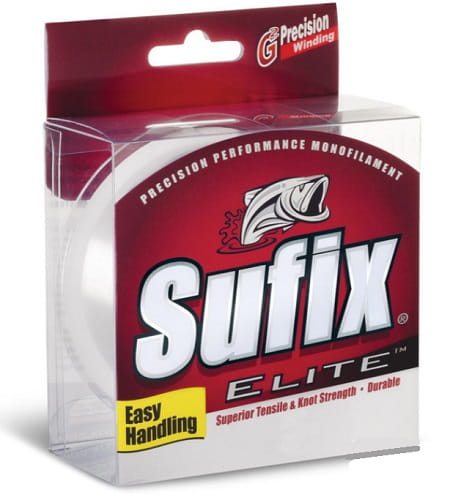
If you are a frequent or more experienced angler, use a 25 to 35-pound braided line for all methods.
When casting lures with a braided line, add a 14 to 17-pound, 16″ to 24″ fluorocarbon leader like Seaguar STS Steelhead Leader. I attach my leader with a quality 2-way swivel like the SPRO Power Swivels.
Lure Fishing Only Line
Braid is likely the best line for anglers who only want to cast lures, and my go-to braid is Sufix 832 Advanced Superline, which is said to be the strongest and most durable braid.
Baidedlines are very thin, which helps cut through the water to get the lure deeper. Braided line also has no stretch, so the hook sets are solid.
The braid is also much thinner, so you can get a lot more on the spool, which is a bonus when those giant steelhead make 300-foot runs.
Fluorocarbon lines are also a good choice for casting lures. They are less visible to the fish, tend to sink, which helps keep the lure down, and are very abrasion-resistant, so they’re good when fishing around a lot of rocks.
Attaching The Lure
There are a few ways that are best to attach your lure to your mainline or your leader.
I mentioned above about using a 16 to 24-inch fluorocarbon leader of 14 to 18-pound test, or 20-pounds, when fishing west coast salmon on very large rivers. I attach the leader using a quality swivel. This is for braided lines, however, I do this will all types of lines.
To attach the lure to the leader or to the mainline using a standard knot like an Improved Clinch Knot. You can tie the mainline directly to the lure. On lures that spin like a Mepps Spinner can cause some serious line twists, which can weaken the line. I generally only tie mono or fluorocarbon directly to crankbaits or plugs like the Kickfish.
The other option is to use a loop knot. Loop knots are supposed to give the lure more freedom to move and create more action. A simple and strong knot like the Kreh Loop Knot works well with lures and is the one I use.
Also, use a good snap swivel. Consider a good snap like the Offshore Angler Ball Bearing Swivel with Coastlock Snap.
Don’t Forget Your Salmon River Gear
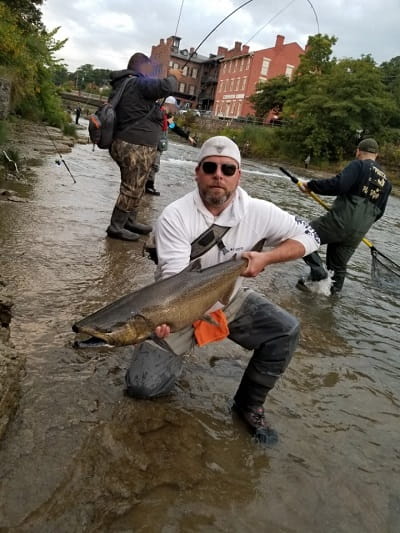
It’s important that you have all the right gear when fishing salmon on rivers.
The right gear will help you get to the fish, stay comfortable and dry, and will help you manage and land your trout.
Using waders will help you position yourself to cover the water better, the proper rod and reel will help you cast and fight the fish, and the proper net will help you land the fish.
You have just read the short and revised version. For more in-depth information, tips, and advice, check out the full article HERE.
Tight Lines
Graham

